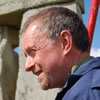
 |
Professor Tim Darvill (pictured) and Ian Hanson have both shared their views |
Archaeology is likely to undergo many changes in the decade ahead. The website ‘Heritage Key’ spoke with two of BU’s leading experts to predict what they think could be the big discoveries, themes, advances and breakthroughs in their individual fields over the next 10 years.
BU Professor Tim Darvill, a leading authority on Bronze Age Britain and Stonehenge, and Ian Hanson, experienced Forensic Archaeologist and Anthorpologist, both shared their views.
Professor Darvill predicts an increase in the quantity and quality of radiocarbon dates which will allow the past to be written in completely new ways.
“Touching people’s lives will be the increasing quantity and quality of radiocarbon dates available for prehistoric sites in Europe, especially in providing a resolution that over the next decade or so will allow the past to be written in completely new ways,” said Professor Darvill. “No longer will be it necessary to rely on the long-redundant mid-nineteenth century Three Age System (Stone, Bronze and Iron Ages), or even its later developed form (Paleolithic, Mesolithic, Neolithic, Bronze Age, Iron Age). Instead we can talk of centuries and perhaps even decades. Events, activities, and sequences will be given human scale. It will finally become possible to say which sites and monuments would have been known to particular individuals and how people's lives related to the construction, lifespan, and abandonment of structures found through excavations and surveys.”
Ian Hanson expects to see the increased use of remote sensing and satellite imagery in archaeology to provide a number of breakthroughs.
"Expect to see increased use of remote sensing and satellite imagery to detect sub surface anomalies and the imaging on websites such as Google Earth of excavations so the mapping the public sees goes 3D and below ground,” said Hanson. “Also, the use of digital video and photography to produce 3D images which wrap around surfaces creating 3D images, and the use of laser scanning for image capture.
“There’ll be a refinement of excavation techniques and recording standards as influences from legal and forensic work in archaeology are applied to routine archaeological excavation and also the use of stable isotope analysis to analyse human, animal and artefact movement in the ancient world,” he concluded.
09/04/10